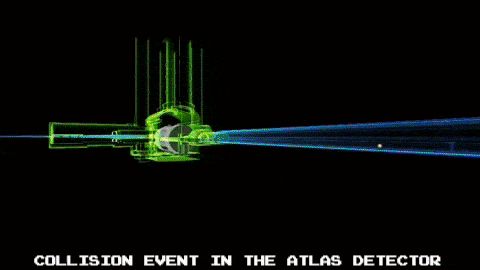CERN - European Organization for Nuclear Research logo.
July 14, 2022
Joint-polarisation measurements of the W and Z bosons provide new opportunities to look for physics beyond the Standard Model
Image above: ATLAS candidate event for a W and a Z boson produced simultaneously with a longitudinal polarisation. (Image: ATLAS/CERN).
In the Standard Model of particle physics, the Brout–Englert–Higgs mechanism provides mass to elementary particles. While physicists are carrying out direct studies of the Higgs boson to test this mechanism, probes of other particles that have mass can also provide insight. For instance, the W and Z bosons – the carriers of the weak force – get their mass from the Higgs mechanism. This impacts their polarisation, that is, the degree by which their quantum spin is aligned to a given direction. The W and Z bosons have a spin of 1 and can be longitudinally polarised as a direct consequence of their being massive – in other words, their spin can be oriented perpendicular to their direction of motion.
The simultaneous production of two W or Z bosons (or “diboson” production) allows physicists to study fundamental interactions between bosons. These rare processes have yet to be fully tested against Standard Model predictions, and studying the polarisation of the produced bosons is a way to potentially unveil new physics effects. While the polarisation of W and Z bosons separately has been studied since the era of the Large Electron–Positron (LEP) collider, the predecessor to the Large Hadron Collider (LHC), two such bosons produced simultaneously with a longitudinal polarisation have never been observed. With the wealth of data collected during Run 2 of the LHC and innovative analysis methods, ATLAS researchers are now able to study the joint-polarisation states of diboson production events.
In a new study presented at the ICHEP 2022 conference, ATLAS physicists have been able to observe events with both a W and a Z boson simultaneously polarised longitudinally for the very first time. To achieve this result, the researchers identified events containing both a W boson and a Z boson. They focused on events where the bosons transform, or “decay”, into particles called leptons, as these leave the clearest signature in the ATLAS detector. The polarisation of the parent bosons in such WZ events manifests itself in angular observables that have very distinct distributions for different polarisation states.
However, not all of the four possible WZ joint-polarisation states – longitudinal–longitudinal, longitudinal–transverse, transverse–longitudinal and transverse–transverse – are equally probable. The most interesting events, with both bosons exhibiting a longitudinal polarisation, are well hidden – they represent only about 7% of all WZ events, amounting to just 1200 of the 17 100 WZ events studied by ATLAS.
Collision event in the ATLAS detector. Animation Credit: CERN
To overcome the main experimental challenges, researchers developed dedicated machine-learning algorithms to extract the fractions of the four types of joint-polarisation events with a relative uncertainty of about 20%, at most. They found that the Standard Model predictions for these fractions always lie within the 95.5% confidence level region of the measurements, meaning that there is no significant tension with the theory. Researchers also found that the product of the two single-boson longitudinal polarisation fractions is about 50% below the actual longitudinal–longitudinal joint-polarisation fraction. This is a direct measure of the role played by correlations between the two bosons and demonstrates that the two single-boson polarisations are not independent.
This result is a fascinating look into some of the most fundamental structures of the Standard Model itself. And the feasibility of joint-polarisation measurements provides new opportunities to look for new physics phenomena, targeting more specific (and rarer) processes. Building on the novel techniques developed here, physicists can now envisage the even more challenging joint-polarisation measurement of the scattering of two longitudinally polarised bosons.
Note:
CERN, the European Organization for Nuclear Research, is one of the world’s largest and most respected centres for scientific research. Its business is fundamental physics, finding out what the Universe is made of and how it works. At CERN, the world’s largest and most complex scientific instruments are used to study the basic constituents of matter — the fundamental particles. By studying what happens when these particles collide, physicists learn about the laws of Nature.
The instruments used at CERN are particle accelerators and detectors. Accelerators boost beams of particles to high energies before they are made to collide with each other or with stationary targets. Detectors observe and record the results of these collisions.
Founded in 1954, the CERN Laboratory sits astride the Franco–Swiss border near Geneva. It was one of Europe’s first joint ventures and now has 23 Member States.
Related article:
ATLAS result addresses long-standing tension in the Standard Model
https://orbiterchspacenews.blogspot.com/2020/07/atlas-result-addresses-long-standing.html
Related links:
Large Electron-Positron (LEP): https://home.cern/science/accelerators/large-electron-positron-collider
Large Hadron Collider (LHC): https://home.cern/science/accelerators/large-hadron-collider
ATLAS: https://home.cern/science/experiments/atlas
Higgs boson: https://home.cern/science/physics/higgs-boson
W boson: https://home.cern/tags/w-boson
W bosons: https://home.cern/about/physics/w-boson-sunshine-and-stardust
Standard Model: https://home.cern/science/physics/standard-model
ICHEP 2022 conference: https://www.ichep2022.it/
ATLAS physicists new study: https://atlas.web.cern.ch/Atlas/GROUPS/PHYSICS/CONFNOTES/ATLAS-CONF-2022-053/
For more information about European Organization for Nuclear Research (CERN), Visit: https://home.cern/
Image (mentioned), Animation (mentioned), Text, Credits: CERN/By ATLAS collaboration.
Best regards, Orbiter.ch



